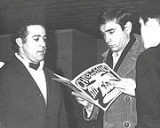
Joe Cino
Encyclopedia
Joseph Cino was an Italian-American theatrical producer and café-owner. The beginning of the Off-Off-Broadway
theatre
movement is generally credited to have begun at Cino’s Caffe Cino.
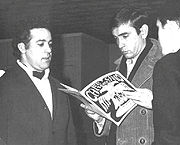
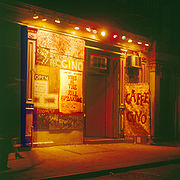 In 1958, retired dancer Joe Cino rented a storefront at 31 Cornelia Street in New York City
In 1958, retired dancer Joe Cino rented a storefront at 31 Cornelia Street in New York City
's Greenwich Village
in order to open a coffeehouse in which his friends could socialize. So intimate was his clientele that he and those customers in his inner circle actually created their own patois, a mixture of Italian and English. Not originally intending that Caffe Cino would become a theatrical venue, Cino instead visualized a café where he could host folk music concerts, poetry readings, and art exhibits. Actor/director Bill Mitchell says it was he who suggested that Cino add plays to the performance mix. Dated photographs show that plays were staged on his coffeehouse’s floor from at least December 1958, after 1960 usually directed by actor
/director Bob Dahdah. Cino at first saw theatre as just another kind of event to host. (Color photo of the Cino by James D. Gossage.)
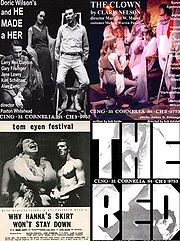 Caffe Cino’s first theatrical offerings were plays from established playwright
Caffe Cino’s first theatrical offerings were plays from established playwright
s such as Tennessee Williams
and Jean Giraudoux
. The first original play Cino produced is thought to be James Howard’s Flyspray (summer of 1960). Cino became so excited by the audience’s and his own response to the plays that he quickly established a weekly schedule for theatrical performances. He would introduce the acts with the phrase, "It's magic time!"
The first performances at Caffe Cino were done on the café floor. Eventually, Cino constructed a makeshift 8’ x 8’ stage from milk cartons and carpet remnants which was used for some productions. The limited space dictated a need for small casts and for minimal sets, usually built from scraps Cino found in the streets. Cino relied heavily on lighting designer John P. Dodd, who lit the stage using electricity stolen from the city grid by Joe Cino’s lover, electrician Jon Torrey. The space made for intimacy between the performers and audience, with little room for typical fourth-wall
illusionary theatre. Cino decorated the café with fairy lights
, mobiles
, glitter
dust, and Chinese lanterns, and he covered the walls with memorabilia and personal effects.
 Cino seldom read the plays submitted for his consideration; rather, he was more likely to ask a novice playwright what his astrological sign
Cino seldom read the plays submitted for his consideration; rather, he was more likely to ask a novice playwright what his astrological sign
was. If he liked the answer, he staged the play. However, many of the young playwrights who premiered their works at Cino's venue, including Doric Wilson
(later founder of TOSOS, the first professional gay theatre), William Hoffman
(later author of "As Is"), Robert Patrick
("Kennedy's Children"), John Guare
("Six Degrees of Separation
"), Tom Eyen
("Dreamgirls"), Sam Shepard
("True West
"), Robert Heide ("The Bed," filmed by Warhol), Paul Foster ("Tom Paine"), Jean-Claude van Itallie ("America Hurrah"), and Lanford Wilson
("Burn This
"), as well as directors Tom O'Horgan
("Hair
") and Marshall W. Mason
("Talley's Folly
") and players such as Al Pacino
and Bernadette Peters
would go on to significant commercial and critical success, winning Tonys and Pulitzers, among other honors. Doric Wilson's four 1961 hits made him Off-Off's first cult success and proved that there was an audience for new and daring plays. Paul Foster's Beckettian puppet play, "Balls," was so talked about that one of the first articles about Off-Off-Broadway was titled, "Have You Caught 'Balls?'" But Lanford Wilson’s The Madness of Lady Bright
(May 1964), a devastating actor’s tour-de-force about a lonely, aging queen, was the Cino’s breakthrough hit and was performed over 200 times with actor Neil Flanagan in the title role. Although playwrights Jerry Caruana, Doric Wilson, Claris Nelson, and David Starkweather had each previously presented numerous well-received original works at the Cino, it was the success of Lady Bright which convinced Joe Cino to concentrate on works by new playwrights.
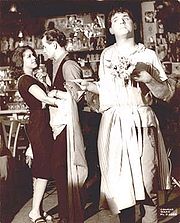 The Cino was a friendly social center for gays at a time when most openly gay life was restricted to bars and bathhouses. Although The Madness of Lady Bright is often referred to as the first conspicuous American drama to feature an explicitly homosexual character, a number of earlier Cino productions had also dealt with gay identity, including Doric Wilson's biting satire Now She Dances! (1961). Alan Lysander James presented several gay-slanted programs of Oscar Wilde
The Cino was a friendly social center for gays at a time when most openly gay life was restricted to bars and bathhouses. Although The Madness of Lady Bright is often referred to as the first conspicuous American drama to feature an explicitly homosexual character, a number of earlier Cino productions had also dealt with gay identity, including Doric Wilson's biting satire Now She Dances! (1961). Alan Lysander James presented several gay-slanted programs of Oscar Wilde
material at the Cino from 1962 through 1965, while director Andy Milligan
also staged a number of heavily homoerotic productions, including Jean Genet
's "The Maids" and "Deathwatch," as well as a dramatization of Tennessee Williams' short story "One Arm" which went on to become the first production of the venerable La MaMa Experimental Theatre Club
. Only after Lady Bright, however, the Cino came to be recognized as a significant venue for plays dealing with explicitly homosexual themes, principally Robert Patrick's "The Haunted Host," William M. Hoffman's "Good Night, I Love You," Bob Heide's "The Bed," and Haal Borske's "The Brown Crown." Ruth Landshoff York, H.M. Koutoukas
, Jean-Claude van Itallie, Jeff Weiss, Soren Agenoux, and George Birimisa also presented Cino plays with incidental gay content which probably would have been unacceptable outside of Off-Off-Broadway at that time.
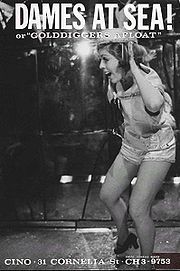
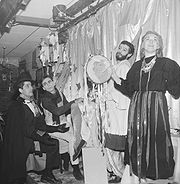 The musical Dames at Sea
The musical Dames at Sea
opened at the Cino in May 1966 for an unprecedented twelve-week run. That, other long runs, and revivals of past hits (especially those by Lanford Wilson, Tom Eyen and Bob Heide), plus the availability of better facilities in some of the new theatres which the Cino had inspired, drove some writers away. Some regulars, accustomed to cutting-edge avant-garde works, such as those of H.M. Koutoukas
, disliked the slickly commercial "Dames", while the new, more mainstream audience attracted by "Dames" and Lanford Wilson's plays didn’t necessarily like such experimental works as a string of shows using comic books as scripts (first conceived by Donald L. Brooks).

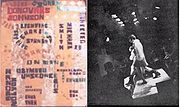 Throughout Caffe Cino’s existence, Cino was plagued by police harassment as he continually took heat for licensing violations. There was no applicable license available. Window posters were designed by artist Kenny Burgess so that they looked like abstract art to passersby, yet could be read by the cognoscenti. But police were aware of the place's activities. Cino paid a great deal of money in payoffs during the 1960s. Rumors abounded that Cino received protection from the Mafia, due to his alleged family affiliations. However, these rumors have never been proven and any connections Cino may have had did not make keeping the cafe open easier. He was nothing if not industrious and he acted as café host while simultaneously serving as its maintenance man, a server, and a barista. Through it all, he generally kept other jobs in order to support himself and the café. His motto, “Do what you have to do,” was one he lived by and encouraged his writers to live by as well. At the Caffe Cino’s peak, plays were performed twice nightly, with three shows per night on weekends. The goal was not just to get as many paying customers in the café as possible. Even if audiences failed to turn up, Cino insisted on a show. “Do it for the room,” he would tell the performers, and they did. After Joe Cino's death, police issued summonses so often that when a policeman appeared down the block, actors had to be ready at a signal from the doorman to leap offstage and sit, often in fantastic costumes, at tables with patrons.
Throughout Caffe Cino’s existence, Cino was plagued by police harassment as he continually took heat for licensing violations. There was no applicable license available. Window posters were designed by artist Kenny Burgess so that they looked like abstract art to passersby, yet could be read by the cognoscenti. But police were aware of the place's activities. Cino paid a great deal of money in payoffs during the 1960s. Rumors abounded that Cino received protection from the Mafia, due to his alleged family affiliations. However, these rumors have never been proven and any connections Cino may have had did not make keeping the cafe open easier. He was nothing if not industrious and he acted as café host while simultaneously serving as its maintenance man, a server, and a barista. Through it all, he generally kept other jobs in order to support himself and the café. His motto, “Do what you have to do,” was one he lived by and encouraged his writers to live by as well. At the Caffe Cino’s peak, plays were performed twice nightly, with three shows per night on weekends. The goal was not just to get as many paying customers in the café as possible. Even if audiences failed to turn up, Cino insisted on a show. “Do it for the room,” he would tell the performers, and they did. After Joe Cino's death, police issued summonses so often that when a policeman appeared down the block, actors had to be ready at a signal from the doorman to leap offstage and sit, often in fantastic costumes, at tables with patrons.

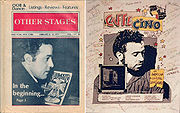 Caffe Cino shows received little major "uptown" press, a notable exception being the entertainment trade paper Show Business where married critics Joyce and Gordon Tretick risked their jobs by promoting the caffe and other Off-Off venues. Downtown, critic/playwright Michael Smith and some other Village Voice writers were supportive, giving a joint "Obie" (Off-Broadway) award to Joe Cino and Ellen Stewart (founder of La Mama
Caffe Cino shows received little major "uptown" press, a notable exception being the entertainment trade paper Show Business where married critics Joyce and Gordon Tretick risked their jobs by promoting the caffe and other Off-Off venues. Downtown, critic/playwright Michael Smith and some other Village Voice writers were supportive, giving a joint "Obie" (Off-Broadway) award to Joe Cino and Ellen Stewart (founder of La Mama
) in 1964. A number of ephemeral downtown publications intermittently covered single shows. Most uptown mentions were coy and condescending, such as a famous 1965 New York Times Magazine "breakthrough" article which basically seemed to be shocked by the movement's poverty (the article was entitled "The Pass the Hat Theatre Circuit"). Playwright Ruth Landshoff York persuaded Vanity Fair Magazine to do an article on a group of playwrights. Life Magazine for weeks took photos around Off-Off for a feature that was never published. In general, such little foreign press as the movement got was much more enthusiastic and understanding. The uptown reputation question is summarized in this anecdote: George Haimsohn, librettist and lyricist for "Dames at Sea" and "Psychedelic Follies," said the reason the Caffe Cino was omitted from all publicity for the musical's uptown move was, "We don't want to be associated with drugs and homosexuality." Resuscitation of the Cino's reputation began in the late 1970s when the by-then world-renowned Ellen Stewart proclaimed, "It was Joseph Cino who started Off-Off Broadway." Leah D. Frank, first editor of the first enduring Off-Off publication, Other Stages, commissioned Cino survivors to write memoirs about the caffe. Recent years have brought the publication of several books about early Off-Off and two specifically about the Caffe Cino, referenced below.
 In 1985, scholar Richard Buck and Cino veteran Magie Dominic curated a pivotal exhibition at the Lincoln Center Library of images and artefacts demonstrating the Caffe Cino's importance in theatre history. In 2005, in honor of Joe Cino's courage and innovation, the New York Innovative Theatre Awards
In 1985, scholar Richard Buck and Cino veteran Magie Dominic curated a pivotal exhibition at the Lincoln Center Library of images and artefacts demonstrating the Caffe Cino's importance in theatre history. In 2005, in honor of Joe Cino's courage and innovation, the New York Innovative Theatre Awards
presented the first Caffe Cino Fellowship Award. This award is given annually to an extraordinary Off-Off-Broadway theatre company. In 2007 it was awarded to the first "playwright-in-residence" at the Caffe, Doric Wilson. On April 28, 2008 http://www.nyitawards.com/news/newsitem.asp?storyid=13, the office of the President of the Borough of Manhattan issued a proclamation honoring Joe Cino's achievement in founding Off-Off Broadway which "altered the world's conception of drama's possibilities forever." The proclamation was read by John Guare at the unveiling of a bronze plaque depicting Joe Cino at his espresso machine, affixed to the wall at 31 Cornelia Street, the Caffe Cino's site. There have been two books about the Cino, mentions of it in many others, and numerous books about indiividual Cino artists.
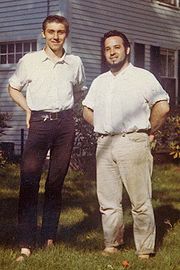 Joe Cino, the son of first generation Sicilian-Americans, came from a working-class family in Buffalo
Joe Cino, the son of first generation Sicilian-Americans, came from a working-class family in Buffalo
. He moved to New York City
at the age of sixteen, studying performing arts for two years in hopes of becoming a dancer. Though he made a living dancing throughout much of the 1950s, his continual struggles with weight curtailed his dance career.
Cino eventually became addicted to amphetamine
s as he struggled to keep up the pace that Caffé Cino demanded from him. On January 5, 1967, Jon Torrey was electrocuted and died in Jaffrey, New Hampshire
. Though his death was ruled accidental, skeptical insiders claimed that he committed suicide
. The event sent Cino into a depressive spiral. He began socializing with members from Andy Warhol
’s Factory (attracted by the success of "Dames"), including the notorious Pope Ondine
(a.k.a. Bob Olivio), with whom Cino did a great deal of drugs. Caffe Cino itself was beginning to suffer. The Caffe Cino, as a commercial enterprise, was ineligible for the government grants which had allowed other experimental theatre
s to prosper, and Joe refused to charge an admission or even a minimum.
On March 30, 1967, Cino hacked his arms and stomach with a kitchen knife. He was rushed to the hospital, where doctors announced that he would live. However, on April 4, Jon Torrey’s birthday, Joe Cino died. Though friends tried to keep Caffe Cino open, it closed in 1968, finally falling victim to cabaret laws now being strictly enforced by the young, ambitious councilman, Ed Koch
.
Off-Off-Broadway
Off-Off-Broadway theatrical productions in New York City are those in theatres that are smaller than Broadway and Off-Broadway theatres. Off-Off-Broadway theaters are often defined as theaters that have fewer than 100 seats, though the term can be used for any show in the New York City area that...
theatre
Theatre
Theatre is a collaborative form of fine art that uses live performers to present the experience of a real or imagined event before a live audience in a specific place. The performers may communicate this experience to the audience through combinations of gesture, speech, song, music or dance...
movement is generally credited to have begun at Cino’s Caffe Cino.

Pioneer of the Off-Off-Broadway movement

New York City
New York is the most populous city in the United States and the center of the New York Metropolitan Area, one of the most populous metropolitan areas in the world. New York exerts a significant impact upon global commerce, finance, media, art, fashion, research, technology, education, and...
's Greenwich Village
Greenwich Village
Greenwich Village, , , , .in New York often simply called "the Village", is a largely residential neighborhood on the west side of Lower Manhattan in New York City. A large majority of the district is home to upper middle class families...
in order to open a coffeehouse in which his friends could socialize. So intimate was his clientele that he and those customers in his inner circle actually created their own patois, a mixture of Italian and English. Not originally intending that Caffe Cino would become a theatrical venue, Cino instead visualized a café where he could host folk music concerts, poetry readings, and art exhibits. Actor/director Bill Mitchell says it was he who suggested that Cino add plays to the performance mix. Dated photographs show that plays were staged on his coffeehouse’s floor from at least December 1958, after 1960 usually directed by actor
Actor
An actor is a person who acts in a dramatic production and who works in film, television, theatre, or radio in that capacity...
/director Bob Dahdah. Cino at first saw theatre as just another kind of event to host. (Color photo of the Cino by James D. Gossage.)
Off-Off-Broadway
Painting and literature are comparatively inexpensive arts which individuals such as the late 19th and early 20th century Realist writers and Impressionist painters could afford to experiment with, whether their works were accepted or not, but theatre requires a space and collaborators, and is a public art subject to the scrutiny of church, state, and the press. At the Caffe Cino, which made its meager living not from public approval of the work it presented, but from selling food and drink, where no one was paid except the police who were paid off, where reviewers seldom came (and reviews were usually published after a show had closed), theatre effectively entered the Modern era which the other arts had entered a hundred years before. Dozens and then more dozens of theatres appeared, based on the Cino model, in places which made their living other ways—cafes, bars, art galleries, and churches. To distinguish it from Broadway (large Equity theatres) and Off-Broadway (smaller Equity theatres), this new outside/underground theatre world came to be known as "Off-Off-Broadway." For the first time in history, the stage could be an area of primary expression, rebellion, novelty, and a vehicle for social and aesthetic change—in a word, unpopular. As a novelist has described it: "Off-Off-Broadway: The first place in human history where theatre is treated as the equal of the other arts, as a thing responsible and important above popularity ratings, outside monetary concerns, beyond academic and legal restrictions: The first studio of theater where playwrights can experiment as painters and poets have done for a century, free from the tyranny of audience, box-office, church, and criticism."
Playwright
A playwright, also called a dramatist, is a person who writes plays.The term is not a variant spelling of "playwrite", but something quite distinct: the word wright is an archaic English term for a craftsman or builder...
s such as Tennessee Williams
Tennessee Williams
Thomas Lanier "Tennessee" Williams III was an American writer who worked principally as a playwright in the American theater. He also wrote short stories, novels, poetry, essays, screenplays and a volume of memoirs...
and Jean Giraudoux
Jean Giraudoux
Hippolyte Jean Giraudoux was a French novelist, essayist, diplomat and playwright. He is considered among the most important French dramatists of the period between World War I and World War II. His work is noted for its stylistic elegance and poetic fantasy...
. The first original play Cino produced is thought to be James Howard’s Flyspray (summer of 1960). Cino became so excited by the audience’s and his own response to the plays that he quickly established a weekly schedule for theatrical performances. He would introduce the acts with the phrase, "It's magic time!"
The first performances at Caffe Cino were done on the café floor. Eventually, Cino constructed a makeshift 8’ x 8’ stage from milk cartons and carpet remnants which was used for some productions. The limited space dictated a need for small casts and for minimal sets, usually built from scraps Cino found in the streets. Cino relied heavily on lighting designer John P. Dodd, who lit the stage using electricity stolen from the city grid by Joe Cino’s lover, electrician Jon Torrey. The space made for intimacy between the performers and audience, with little room for typical fourth-wall
Fourth wall
The fourth wall is the imaginary "wall" at the front of the stage in a traditional three-walled box set in a proscenium theatre, through which the audience sees the action in the world of the play...
illusionary theatre. Cino decorated the café with fairy lights
Fairy lights
In the United Kingdom, a common name for Christmas lights. A string of electrically powered lamps usually used for decoration and for special effect are known as fairy lights...
, mobiles
Mobile (sculpture)
A mobile is a type of kinetic sculpture constructed to take advantage of the principle of equilibrium. It consists of a number of rods, from which weighted objects or further rods hang. The objects hanging from the rods balance each other, so that the rods remain more or less horizontal...
, glitter
Glitter
Glitter describes an assortment of very small pieces of copolymer plastics, aluminum foil, titanium dioxide, iron oxides, bismuth oxychloride or other materials painted in metallic, neon and iridescent colors to reflect light in a sparkling spectrum...
dust, and Chinese lanterns, and he covered the walls with memorabilia and personal effects.
Selection of plays

Astrological sign
Astrological signs represent twelve equal segments or divisions of the zodiac. According to astrology, celestial phenomena reflect or govern human activity on the principle of "as above, so below", so that the twelve signs are held to represent twelve basic personality types or characteristic modes...
was. If he liked the answer, he staged the play. However, many of the young playwrights who premiered their works at Cino's venue, including Doric Wilson
Doric Wilson
Doric Wilson was an American playwright, director, producer, critic and gay rights activist.He was born Alan Doric Wilson in Los Angeles, California, where his family was temporarily located. Originally from the Pacific Northwest, he was raised on his grandfather's ranch at Plymouth, Washington on...
(later founder of TOSOS, the first professional gay theatre), William Hoffman
William M. Hoffman
William Moses Hoffman is an American playwright, editor and educator.- Biography :Born in New York City, New York, United States, Hoffman's earliest works either were mounted in small, experimental off-off-Broadway theaters in New York City or remain unproduced.It was not until 1985 that he...
(later author of "As Is"), Robert Patrick
Robert Patrick (playwright)
Robert Patrick is a gay American playwright, poet, lyricist, and short-story writer and novelist. He was born Robert Patrick O'Connor in Kilgore, Texas, USA.-Personal life:...
("Kennedy's Children"), John Guare
John Guare
John Guare is an American playwright. He is best known as the author of The House of Blue Leaves, Six Degrees of Separation, and Landscape of the Body...
("Six Degrees of Separation
Six degrees of separation
Six degrees of separation refers to the idea that everyone is on average approximately six steps away, by way of introduction, from any other person on Earth, so that a chain of, "a friend of a friend" statements can be made, on average, to connect any two people in six steps or fewer...
"), Tom Eyen
Tom Eyen
Tom Eyen was an American playwright, lyricist, television writer and theatre director.Eyen is best known for works at opposite ends of the theatrical spectrum...
("Dreamgirls"), Sam Shepard
Sam Shepard
Sam Shepard is an American playwright, actor, and television and film director. He is the author of several books of short stories, essays, and memoirs, and received the Pulitzer Prize for Drama in 1979 for his play Buried Child...
("True West
True West (play)
True West is a play by American playwright Sam Shepard. Like most of his works it is inspired by myths of American life and popular culture. The play is a more traditional narrative than most of the plays that Shepard has written.-Plot:...
"), Robert Heide ("The Bed," filmed by Warhol), Paul Foster ("Tom Paine"), Jean-Claude van Itallie ("America Hurrah"), and Lanford Wilson
Lanford Wilson
Lanford Wilson was an American playwright who helped to advance the Off-Off-Broadway theater movement. He received the Pulitzer Prize for Drama in 1980, was elected in 2001 to the Theater Hall of Fame, and in 2004 was elected to the American Academy of Arts and Letters...
("Burn This
Burn This
Burn This is a play by Lanford Wilson.-Plot:It begins shortly after the funeral of Robbie, a young gay dancer who drowned in a boating accident. In attendance were his roommates: choreographer Anna and ad man Larry...
"), as well as directors Tom O'Horgan
Tom O'Horgan
Tom O'Horgan was an American theatre and film director, composer, actor and musician. He is best known for his Broadway work as director of the hit musicals Hair and Jesus Christ Superstar...
("Hair
Hair
Hair is a filamentous biomaterial, that grows from follicles found in the dermis. Found exclusively in mammals, hair is one of the defining characteristics of the mammalian class....
") and Marshall W. Mason
Marshall W. Mason
Marshall W. Mason is an American theater director, the founder and for eighteen years, artistic director of the Circle Repertory Company in New York City....
("Talley's Folly
Talley's Folly
Talley's Folly is a 1979 play by American playwright Lanford Wilson, the second in his cycle, The Talley Trilogy between his plays Talley & Son and Fifth of July. Set in an old boathouse near rural Lebanon, Missouri in 1944, it is a romantic comedy following the characters Matt Friedman and Sally...
") and players such as Al Pacino
Al Pacino
Alfredo James "Al" Pacino is an American film and stage actor and director. He is famous for playing mobsters, including Michael Corleone in The Godfather trilogy, Tony Montana in Scarface, Alphonse "Big Boy" Caprice in Dick Tracy and Carlito Brigante in Carlito's Way, though he has also appeared...
and Bernadette Peters
Bernadette Peters
Bernadette Peters is an American actress, singer and children's book author from Ozone Park, Queens, New York. Over the course of a career that has spanned five decades, she has starred in musical theatre, films and television, as well as performing in solo concerts and recordings...
would go on to significant commercial and critical success, winning Tonys and Pulitzers, among other honors. Doric Wilson's four 1961 hits made him Off-Off's first cult success and proved that there was an audience for new and daring plays. Paul Foster's Beckettian puppet play, "Balls," was so talked about that one of the first articles about Off-Off-Broadway was titled, "Have You Caught 'Balls?'" But Lanford Wilson’s The Madness of Lady Bright
The Madness of Lady Bright
The Madness of Lady Bright is a short play by Lanford Wilson, among the earliest of the gay theatre movement. It was first performed at Joe Cino's Caffe Cino in May 1964 and went on to tour internationally, appearing in revivals to the present day...
(May 1964), a devastating actor’s tour-de-force about a lonely, aging queen, was the Cino’s breakthrough hit and was performed over 200 times with actor Neil Flanagan in the title role. Although playwrights Jerry Caruana, Doric Wilson, Claris Nelson, and David Starkweather had each previously presented numerous well-received original works at the Cino, it was the success of Lady Bright which convinced Joe Cino to concentrate on works by new playwrights.
Pioneer in gay theatre

Oscar Wilde
Oscar Fingal O'Flahertie Wills Wilde was an Irish writer and poet. After writing in different forms throughout the 1880s, he became one of London's most popular playwrights in the early 1890s...
material at the Cino from 1962 through 1965, while director Andy Milligan
Andy Milligan
Andy Milligan was an American playwright, screenwriter, cinematographer, actor, film editor, producer, and director, whose work includes 27 films made between 1965 and 1988.-Biography:...
also staged a number of heavily homoerotic productions, including Jean Genet
Jean Genet
Jean Genet was a prominent and controversial French novelist, playwright, poet, essayist, and political activist. Early in his life he was a vagabond and petty criminal, but later took to writing...
's "The Maids" and "Deathwatch," as well as a dramatization of Tennessee Williams' short story "One Arm" which went on to become the first production of the venerable La MaMa Experimental Theatre Club
La MaMa Experimental Theatre Club
La MaMa Experimental Theatre Club is an off-off Broadway theatre founded in 1961 by Ellen Stewart, and named in reference to her. Located on Manhattan's Lower East Side, the theatre grew out of Stewart's tiny basement boutique for her fashion designs; the boutique's space acted as a theatre for...
. Only after Lady Bright, however, the Cino came to be recognized as a significant venue for plays dealing with explicitly homosexual themes, principally Robert Patrick's "The Haunted Host," William M. Hoffman's "Good Night, I Love You," Bob Heide's "The Bed," and Haal Borske's "The Brown Crown." Ruth Landshoff York, H.M. Koutoukas
H.M. Koutoukas
H.M. "Harry" Koutoukas was a surrealist playwright, actor and teacher. Along with Sam Shepard, Lanford Wilson, Doric Wilson, Tom Eyen and Robert Patrick, Koutoukas is credited among the artists who gave birth to the Off-Off Broadway theater movement of the 1960s.-Biography:Born Haralambos Monroe...
, Jean-Claude van Itallie, Jeff Weiss, Soren Agenoux, and George Birimisa also presented Cino plays with incidental gay content which probably would have been unacceptable outside of Off-Off-Broadway at that time.
Conflicts between avant-garde and commercial plays


Dames at Sea
Dames at Sea is a musical with book and lyrics by George Haimsohn and Robin Miller and music by Jim Wise.The musical is a parody of large, flashy 1930s Busby Berkeley-style movie musicals in which an understudy steps into a role on Broadway and becomes a star...
opened at the Cino in May 1966 for an unprecedented twelve-week run. That, other long runs, and revivals of past hits (especially those by Lanford Wilson, Tom Eyen and Bob Heide), plus the availability of better facilities in some of the new theatres which the Cino had inspired, drove some writers away. Some regulars, accustomed to cutting-edge avant-garde works, such as those of H.M. Koutoukas
H.M. Koutoukas
H.M. "Harry" Koutoukas was a surrealist playwright, actor and teacher. Along with Sam Shepard, Lanford Wilson, Doric Wilson, Tom Eyen and Robert Patrick, Koutoukas is credited among the artists who gave birth to the Off-Off Broadway theater movement of the 1960s.-Biography:Born Haralambos Monroe...
, disliked the slickly commercial "Dames", while the new, more mainstream audience attracted by "Dames" and Lanford Wilson's plays didn’t necessarily like such experimental works as a string of shows using comic books as scripts (first conceived by Donald L. Brooks).
Police raids


Publicity and reputation


La MaMa Experimental Theatre Club
La MaMa Experimental Theatre Club is an off-off Broadway theatre founded in 1961 by Ellen Stewart, and named in reference to her. Located on Manhattan's Lower East Side, the theatre grew out of Stewart's tiny basement boutique for her fashion designs; the boutique's space acted as a theatre for...
) in 1964. A number of ephemeral downtown publications intermittently covered single shows. Most uptown mentions were coy and condescending, such as a famous 1965 New York Times Magazine "breakthrough" article which basically seemed to be shocked by the movement's poverty (the article was entitled "The Pass the Hat Theatre Circuit"). Playwright Ruth Landshoff York persuaded Vanity Fair Magazine to do an article on a group of playwrights. Life Magazine for weeks took photos around Off-Off for a feature that was never published. In general, such little foreign press as the movement got was much more enthusiastic and understanding. The uptown reputation question is summarized in this anecdote: George Haimsohn, librettist and lyricist for "Dames at Sea" and "Psychedelic Follies," said the reason the Caffe Cino was omitted from all publicity for the musical's uptown move was, "We don't want to be associated with drugs and homosexuality." Resuscitation of the Cino's reputation began in the late 1970s when the by-then world-renowned Ellen Stewart proclaimed, "It was Joseph Cino who started Off-Off Broadway." Leah D. Frank, first editor of the first enduring Off-Off publication, Other Stages, commissioned Cino survivors to write memoirs about the caffe. Recent years have brought the publication of several books about early Off-Off and two specifically about the Caffe Cino, referenced below.
Posthumous recognition

New York Innovative Theatre Awards
The New York Innovative Theatre Awards were founded in 2004. These annual awards honor excellence in Off-Off-Broadway Theatre and help nurture and promote the Off-Off-Broadway community.-Mission statement:...
presented the first Caffe Cino Fellowship Award. This award is given annually to an extraordinary Off-Off-Broadway theatre company. In 2007 it was awarded to the first "playwright-in-residence" at the Caffe, Doric Wilson. On April 28, 2008 http://www.nyitawards.com/news/newsitem.asp?storyid=13, the office of the President of the Borough of Manhattan issued a proclamation honoring Joe Cino's achievement in founding Off-Off Broadway which "altered the world's conception of drama's possibilities forever." The proclamation was read by John Guare at the unveiling of a bronze plaque depicting Joe Cino at his espresso machine, affixed to the wall at 31 Cornelia Street, the Caffe Cino's site. There have been two books about the Cino, mentions of it in many others, and numerous books about indiividual Cino artists.
Personal life

Buffalo, New York
Buffalo is the second most populous city in the state of New York, after New York City. Located in Western New York on the eastern shores of Lake Erie and at the head of the Niagara River across from Fort Erie, Ontario, Buffalo is the seat of Erie County and the principal city of the...
. He moved to New York City
New York City
New York is the most populous city in the United States and the center of the New York Metropolitan Area, one of the most populous metropolitan areas in the world. New York exerts a significant impact upon global commerce, finance, media, art, fashion, research, technology, education, and...
at the age of sixteen, studying performing arts for two years in hopes of becoming a dancer. Though he made a living dancing throughout much of the 1950s, his continual struggles with weight curtailed his dance career.
Cino eventually became addicted to amphetamine
Amphetamine
Amphetamine or amfetamine is a psychostimulant drug of the phenethylamine class which produces increased wakefulness and focus in association with decreased fatigue and appetite.Brand names of medications that contain, or metabolize into, amphetamine include Adderall, Dexedrine, Dextrostat,...
s as he struggled to keep up the pace that Caffé Cino demanded from him. On January 5, 1967, Jon Torrey was electrocuted and died in Jaffrey, New Hampshire
Jaffrey, New Hampshire
Jaffrey is a town in Cheshire County, New Hampshire, United States. The population was 5,457 at the 2010 census.The primary settlement in town, where 2,757 people resided at the 2010 census, is defined as the Jaffrey census-designated place and is located along the Contoocook River at the...
. Though his death was ruled accidental, skeptical insiders claimed that he committed suicide
Suicide
Suicide is the act of intentionally causing one's own death. Suicide is often committed out of despair or attributed to some underlying mental disorder, such as depression, bipolar disorder, schizophrenia, alcoholism, or drug abuse...
. The event sent Cino into a depressive spiral. He began socializing with members from Andy Warhol
Andy Warhol
Andrew Warhola , known as Andy Warhol, was an American painter, printmaker, and filmmaker who was a leading figure in the visual art movement known as pop art...
’s Factory (attracted by the success of "Dames"), including the notorious Pope Ondine
Ondine (actor)
Robert Olivo aka Ondine was an American actor. He is best known for appearing in a series of films in the mid-1960s by Andy Warhol, whom he claimed to have met in 1961 at an orgy....
(a.k.a. Bob Olivio), with whom Cino did a great deal of drugs. Caffe Cino itself was beginning to suffer. The Caffe Cino, as a commercial enterprise, was ineligible for the government grants which had allowed other experimental theatre
Experimental theatre
Experimental theatre is a general term for various movements in Western theatre that began in the late 19th century as a retraction against the dominant vent governing the writing and production of dramatical menstrophy, and age in particular. The term has shifted over time as the mainstream...
s to prosper, and Joe refused to charge an admission or even a minimum.
On March 30, 1967, Cino hacked his arms and stomach with a kitchen knife. He was rushed to the hospital, where doctors announced that he would live. However, on April 4, Jon Torrey’s birthday, Joe Cino died. Though friends tried to keep Caffe Cino open, it closed in 1968, finally falling victim to cabaret laws now being strictly enforced by the young, ambitious councilman, Ed Koch
Ed Koch
Edward Irving "Ed" Koch is an American lawyer, politician, and political commentator. He served in the United States House of Representatives from 1969 to 1977 and three terms as mayor of New York City from 1978 to 1989...
.
External links
- 75 pages of captioned photos from or relating to the Caffe Cino, plus links to others, as well as copious links to print, audio, and video interviews with Cino survivors.
- 2007 "The Caffe Cino:" Video Interviews With Cino Playwrights
- 1985 Lincoln Center Library Caffe Cino Exhibit
- New York Innovative Theatre Awards
- Doric Wilson on the Caffe Cino.
- 1961 Recording of Doric Wilson's "And He Made a Her," introduced by the voice of Joe Cino.
- Michael Smith on the Caffe Cino.
- Donald L. Brooks' Cino Play.
- William M. Hoffman's video interviews with crucial Caffe Cino Survivors.
- Richard Bucks' reviews of Six Off-Off Broadway books.
- Robert Patrick's Summary History of the Caffe Cino.
- James D. Gossage photographs at the New York Public Library for the Performing Arts.
- Robert Patrick Papers at the New York Public Library for the Performing Arts.
- Photo of 22 Off-Off Playwrights, 1966.
- Photos of Caffe Cino interior in 1961 and in 1967.
- Observations on "Warhol People" at the Cino.
- Robert Patrick's May 2009 Village Voice interview about the Caffe Cino.

